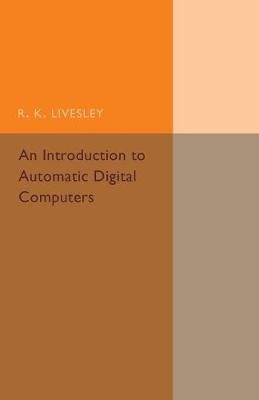
An Introduction to Automatic Digital Computers
Seiten
2017
Cambridge University Press (Verlag)
978-1-316-63330-4 (ISBN)
Cambridge University Press (Verlag)
978-1-316-63330-4 (ISBN)
Originally published in 1960, this textbook is aimed at those without advanced mathematical training and provides a comprehensive introductory account of digital computers, what they are capable of doing and how they are made to do it. Throughout the book the emphasis is on the applications of computers to routine work rather than to advanced research.
Originally published in 1960, as the second edition of a 1957 original, this textbook is aimed at those without advanced mathematical training and provides a comprehensive introductory account of digital computers, what they are capable of doing and how they are made to do it. It begins with a discussion of programming - the preparation of instructions for the computer. This leads on to a consideration of systems of number storage, from the simple decimal system of desk calculating machines to the varieties of binary storage systems used in modern high-speed computers. The final chapter considers points, which arise in applying computers to engineering calculations, and gives details of some of the problems already solved in this way. Throughout the book the emphasis is on the applications of computers to routine work rather than to advanced research. This book will be of value to students of the history of computer science.
Originally published in 1960, as the second edition of a 1957 original, this textbook is aimed at those without advanced mathematical training and provides a comprehensive introductory account of digital computers, what they are capable of doing and how they are made to do it. It begins with a discussion of programming - the preparation of instructions for the computer. This leads on to a consideration of systems of number storage, from the simple decimal system of desk calculating machines to the varieties of binary storage systems used in modern high-speed computers. The final chapter considers points, which arise in applying computers to engineering calculations, and gives details of some of the problems already solved in this way. Throughout the book the emphasis is on the applications of computers to routine work rather than to advanced research. This book will be of value to students of the history of computer science.
List of plates; Preface to the first edition; Preface to the second edition; 1. The elements of programming; 2. Input, storage and output of numbers; 3. The organization of programmes; 4. The solution of engineering problems; References for further reading; Index.
| Erscheinungsdatum | 01.03.2017 |
|---|---|
| Zusatzinfo | Worked examples or Exercises |
| Verlagsort | Cambridge |
| Sprache | englisch |
| Maße | 140 x 217 mm |
| Gewicht | 100 g |
| Themenwelt | Geschichte ► Teilgebiete der Geschichte ► Technikgeschichte |
| Mathematik / Informatik ► Informatik ► Netzwerke | |
| Informatik ► Weitere Themen ► Hardware | |
| Mathematik / Informatik ► Mathematik ► Analysis | |
| Mathematik / Informatik ► Mathematik ► Geschichte der Mathematik | |
| ISBN-10 | 1-316-63330-6 / 1316633306 |
| ISBN-13 | 978-1-316-63330-4 / 9781316633304 |
| Zustand | Neuware |
| Haben Sie eine Frage zum Produkt? |
Mehr entdecken
aus dem Bereich
aus dem Bereich
Digitalisierung neu denken für eine gerechte Gesellschaft
Buch | Hardcover (2023)
Quadriga (Verlag)
20,00 €
In zehn Schritten zum Erfolg | Für alle Selbstständigen
Buch | Hardcover (2024)
Stiftung Warentest (Verlag)
39,90 €
Eine superschnelle Menschheitsgeschichte des digitalen Universums
Buch | Hardcover (2024)
Heyne (Verlag)
24,00 €


